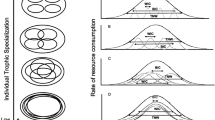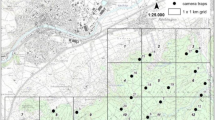Summary
There are, at least, three possible ways in which similar species coexist; resource partitioning, interference competition, and exploitation competition. Here, I investigated which way contributed to the coexistence of leafroller-hunting eumenid wasp species. Resource partitioning and, in addition, differential diet breadths proved to promote species coexistence in this case.
First, I analyze the prey records and diet overlap of four eumenid species in a local area. The larger two eumenids hunted similar-sized prey items and had similar potential taxonomic prey uses. But the diet breadth of the subsocial eumenid was much wider than that of the solitary one. As a result, the diet overlap between the two large eumenids decreased. This was because the solitary eumenid attend repeatedly to the same hunting site inhabited by one abundant prey species, while the subsocial one made random hunting. On the other hand, the two medium-sized eumenids partitioned resources according to prey size.
Secondly, I related these results to prey choice by several other species of eumenid obtained from literature sources. Ten Japanese common eumenids were divided into four groups according to their prey size. In each of the four groups, 2 to 3 wasp species differentiated the habitat (1 group) or coexisted by means of differential diet breadths (parallel with differential sociality, 2 groups).
Similar content being viewed by others
References
Davidson, D. W. (1977) Foraging ecology and community organization in desert seed-eating ants.Ecology 58: 725–737.
Evans, H. E. (1970) Ecological-behavioral studies of the wasps of Jackson Hole, Wyoming.Bull. Mus. Comp. Zool. 140: 451–511.
Hutchinson, G. E., and R. H. MacArthur. (1959) On the theoretical significance of aggressive neglect in intraspecific competition.Amer. Natur. 93: 133–134.
Itino, T. (1986) Comparison of life tables between the solitary eumenid waspAnterhynchium flavomarginatum and the subsocial eumenid waspOrancistrocerus drewseni to evaluate the adaptive significance of maternal care.Res. Popul. Ecol. 28: 185–199.
Itino, T. (1988) The spatial patterns of parasitism of eumenid wasps,Anterhynchium flavomarginatum andOrancistrocerus drewseni by the miltogrammine flyAmobia distorta.Res. Popul. Ecol. 30: 1–12.
Iwata, K. (1938) Habits of eight species of Eumenidae (Rhynchium, Lionotus, andSymmorphus) in Japan.Mushi 11: 110–132.
Iwata, K. (1975)Field notes of a naturalist. Asahi-sinbun-sya, Tokyo, Japan. (In Japanese)
Iwata, K. (1976)Evolution of instinct: comparative ethology of Hymenoptera Amerind Publishing Company, New Delhi, India.
Iwata, K. (1979)Fifty year field notes of an entomologist. Vol. 3. Asahi-sinbun-sya, Tokyo, Japan. (In Japanese)
Iwata, K. (1980)Fifty year field notes of an entomologist. Vol. 4. Asahi-sinbun-sya, Tokyo, Japan. (In Japanese)
Johnson, L. K. and S. P. Hubbell. (1974) Aggression and competition among stingless bees: field studies.Ecology 55: 120–127.
Johnson, L. K. and S. P. Hubbell. (1975) Contrasting foraging strategies and coexistence of two bee species on a single resource.Ecology 56: 1398–1406.
MacArthur, R. H., and R. Levins. (1967) The limiting similarity, convergence, and divergence of coexisting species.Amer. Natur. 101: 377–385.
May, R. M., and R. H. MacArthur. (1972) Niche overlap as a function of environmental variability.Proc. Natl. Acad. Sci. U.S.A. 69: 1109–1113.
Miller, R. S. (1967) Pattern and process in competition.Adv. Ecol. Res. 4: 1–74.
O’Neill, K. M. and H. E. Evans. (1982) Patterns of prey use in four sympatric species ofPhilanthus (Hymenoptera: Sphecidae) with a review of prey selection in the genus.Journal of Natural History 16: 791–801.
Pulliam, R. H. (1975) Coexistence of sparrows: a test of community theory.Science 189: 474–476.
Schaffer, W. M., D. B. Jensen, D. E. Hobbs, J. Gurevitch, J. R. Todd and M. V. Schaffer. (1979) Competition, foraging energetics, and the cost of sociality in three species of bees.Ecology 60: 976–987.
Werner, E. E. (1977) Species packing and niche complementarity in three sunfishes.Amer. Natur. 111: 553–578.
Yamane, Sk. (1990) A revision of the Japanese Eumenidae (Hymenoptera, Vespoidea).Insecta Matsumurana New Series 43: 1–189.
Author information
Authors and Affiliations
Additional information
Contribution to the ecological studies of the eumenid wasps. III.
Rights and permissions
About this article
Cite this article
Itino, T. Differential diet breadths and species coexistence in leafroller-hunting eumenid wasps. Res Popul Ecol 34, 203–211 (1992). https://doi.org/10.1007/BF02513531
Issue Date:
DOI: https://doi.org/10.1007/BF02513531




